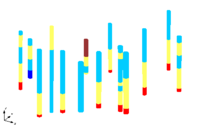GMS:Borehole Hydrogeologic Units
Hydrogeologic units (HGUs) can be defined on boreholes. HGUs are typically a simplified representation of the soil layers from the borehole field data. For example, the borehole log may include several types of sand ("brown sand", "gray silty sand", "clean sand"), but for modeling purposes, treat these all as one material, "sand". GMS now shows both the original soils and the simplified HGUs on the boreholes.
Contents
Importing Borehole Data
When importing borehole data, both an HGU and Soil ID column can be specified in the input. Files containing only a single set of materials can be imported to either field and the other field can be populated using the conversion tools described below.
Creation
The HGU and soil IDs can be edited using the Borehole Editor.
Display
The boreholes can be displayed in the main graphics window using either the HGU IDs or the soil IDs. The ID used for display can be selected in the Display Options dialog.
Soils → HGUs, HGUs → Soils
A set of soil IDs can be converted to a set of HGU IDs using the Soils→HGUs command in the Borehole menu. Likewise, a set of HGU IDs can be converted to a set of soil IDs using the HGUs→Soils command.
Building Cross-Sections, Solids
When building cross-sections or solid models using boreholes, the HGU IDs are used by GMS. The soil IDs are used purely for visualization or for setting up the HGU IDs.
| GMS – Groundwater Modeling System | ||
|---|---|---|
| Modules: | 2D Grid • 2D Mesh • 2D Scatter Point • 3D Grid • 3D Mesh • 3D Scatter Point • Boreholes • GIS • Map • Solid • TINs • UGrids | |
| Models: | FEFLOW • FEMWATER • HydroGeoSphere • MODAEM • MODFLOW • MODPATH • mod-PATH3DU • MT3DMS • MT3D-USGS • PEST • PHT3D • RT3D • SEAM3D • SEAWAT • SEEP2D • T-PROGS • ZONEBUDGET | |
| Aquaveo | ||

